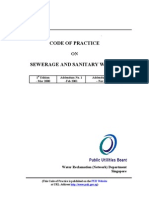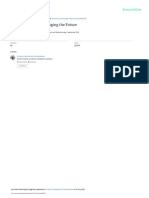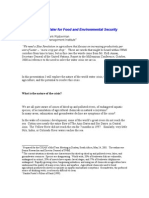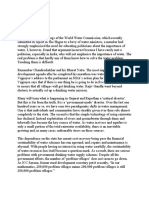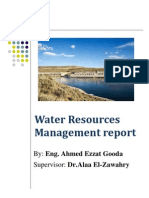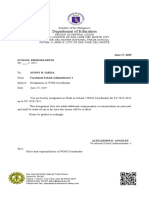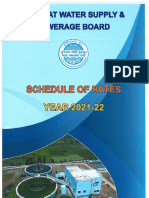Water Crisis
Water Crisis
Uploaded by
Tarun PathakCopyright:
Available Formats
Water Crisis
Water Crisis
Uploaded by
Tarun PathakCopyright
Available Formats
Share this document
Did you find this document useful?
Is this content inappropriate?
Copyright:
Available Formats
Water Crisis
Water Crisis
Uploaded by
Tarun PathakCopyright:
Available Formats
Water Crisis
While the world's population tripled in the 20th century, the use of renewable water resources has grown six-fold. Within the next fifty years, the world population will increase by another 40 to 50 %. This population growth - coupled with industrialization and urbanization - will result in an increasing demand for water and will have serious consequences on the environment.
People lack drinking water and sanitation
Photo by ADMVB bokidiawe@yahoogroupes.fr
Already there is more waste water generated and dispersed today than at any other time in the history of our planet: more than one out of six people lack access to safe drinking water, namely 1.1 billion people, and more than two out of six lack adequate sanitation, namely 2.6 billion people (Estimation, by theWHO/UNICEF JMP,). 3900 children die every day from water borne diseases (WHO ). One must know that these figures represent only people with very poor conditions. In reality, these figures should be much higher.
Water resources are becoming scarce
Agricultural crisis Although food security has been significantly increased in the past thirty years, water withdrawals for irrigation represent 66 % of the total withdrawals and up to 90 % in arid regions, the other 34 % being used by domestic households (10 %), industry (20 %), or evaporated from reservoirs (4 %). (Source: Shiklomanov) As the per capita use increases due to changes in lifestyle and as population increases as well, the proportion of water for human use is increasing. This, coupled with spatial and temporal variations in water availability, means that the water to produce food for human consumption, industrial processes and all the other uses is becoming scarce. Environmental crisis It is all the more critical that increased water use by humans does not only reduce the amount of water available for industrial and agricultural development but has a profound effect on aquatic ecosystems and their dependent species. Environmental balances are disturbed and cannot play their regulating role anymore. (See Water and Nature)
The concept of Water Stress
Source: WaterGAP 2.0 Water stress results from an imbalance between water use and water resources. The water stress indicator in this map measures the proportion of water withdrawal with respect to total renewable resources. It is a criticality ratio, which implies that water stress depends on the variability of resources. Water stress causes deterioration of fresh water resources in terms of quantity (aquifer over-exploitation, dry rivers, etc.) and quality (eutrophication, organic matter pollution, saline intrusion, etc.) The value of this criticality ratio that indicates high water stress is based on expert judgment and experience (Alcamo and others,). It ranges between 20 % for basins with highly variable runoff and 60 % for temperate zone basins. In this map, we take an overall value of 40 % to indicate high water stress. We see that the situation is heterogeneous over the world. An increase in tensions As the resource is becoming scarce, tensions among different users may intensify, both at the national and international level. Over 260 river basins are shared by two or more countries. In the absence of strong institutions and agreements, changes within a basin can lead to transboundary tensions. When major projects proceed without regional collaboration, they can become a
point of conflicts, heightening regional instability. The Parana La Plata, the Aral Sea, the Jordan and the Danube may serve as examples. Due to the pressure on the Aral Sea, half of its superficy has disappeared, representing 2/3 of its volume. 36 000 km 2 of marin grounds are now recovered by salt.
Towards a way to impove the situation
"There is a water crisis today. But the crisis is not about having too little water to satisfy our needs. It is a crisis of managing water so badly that billions of people - and the environment - suffer badly." World Water Vision Report With the current state of affairs, correcting measures still can be taken to avoid the crisis to be worsening. There is a increasing awareness that our freshwater resources are limited and need to be protected both in terms of quantity and quality. This water challenge affects not only the water community, but also decision-makers and every human being."Water is everybody's business" was one the the key messages of the 2nd World Water Forum. Saving water resources Whatever the use of freshwater (agriculture, industry, domestic use), huge saving of water and improving of water management is possible. Almost everywhere, water is wasted, and as long as people are not facing water scarcity, they believe access to water is an obvious and natural thing. With urbanization and changes in lifestyle, water consumption is bound to increase. However, changes in food habits, for example, may reduce the problem, knowing that growing 1kg of potatoes requires only 100 litres of water, whereas 1 kg of beef requires 13 000 litres. Improving drinking water supply Water should be recognized as a great priority. One of the main objectives of the World Water Council is to increase awareness of the water issue. Decision-makers at all levels must be implicated. One of the Millenium Development Goals is to halve, by 2015, the proportion of people without sustainable access to safe drinking water and sanitation. To that aim, several measures should be taken:
evaluate and monitor water resources. Improving transboundary cooperation As far as transboundary conflicts are concerned, regional economic developement and cultural preservation can all be strengthened by states cooperating of water. Instead of a trend towards war, water management can be viewed as a trend towards cooperation and peace. Many initiatives are launched to avoid crises. Institutional commitments like in the Senegal River are created. In 2001, Unesco and Grenn Cross International have joined forces in response to the growing threat of conflicts linked to water. They launched the joint From Potential Conflicts to CoOperation Potential programme to promote peace in the use of transboundary watercourses by addressing conflicts and fostering co-operation among states and stakeholders. Facts and Figures 1.1 billion people live without clean drinking water 2.6 billion people lack adequate sanitation(2002, UNICEF/WHO JMP 2004) 1.8 million people die every year from diarrhoeal diseases. 3 900 children die every day from water bornediseases (WHO 2004) Daily per capita use of water in residential areas: - 350 litres in North America and Japan - 200 litres in Europe - 10-20 litres in sub-Saharan Africa Over 260 river basins are shared by two or more countries mostly without adequate legal or institutional arrangements. Quantity of water needed to produce 1 kg of: - wheat: 1 000 L - rice: 1 400 L - beef: 13 000 L (D.Zimmer,and D.Renault, 2003) Resources / Supply By water resources, we mean all the water available for human use, namely domestic use, agriculture, industry. By water supply, we mean water that has been treated and has become drinking water. The poorer the country, the smaller the difference, as people often drink water without treatment. As long as the country develops, the management of water resources in general differs from the one of drinking water.
guarantee the right to water; decentralise the responsibility for water; develop know-how at the local level; increase and improve financing;
You might also like
- (Multiphysics Modeling) Jochen Bundschuh, Mario César Suárez Arriaga-Introduction To The Numerical Modeling of Groundwater and Geothermal Systems - Fundamentals of Mass, Energy and Solute Transport inDocument451 pages(Multiphysics Modeling) Jochen Bundschuh, Mario César Suárez Arriaga-Introduction To The Numerical Modeling of Groundwater and Geothermal Systems - Fundamentals of Mass, Energy and Solute Transport inSi Ham100% (1)
- Royu PP R PipesDocument2 pagesRoyu PP R PipesJoseph Valencia100% (2)
- Start Up System and Seperator Logics - 660MW (DHI Make) BoilerDocument44 pagesStart Up System and Seperator Logics - 660MW (DHI Make) BoilerHemendra Verma100% (1)
- Code of Practice On Sewerage and Sanitary WorksDocument56 pagesCode of Practice On Sewerage and Sanitary Worksexlife86100% (2)
- Water CrisesDocument3 pagesWater CrisesWasifNo ratings yet
- The Global Water Crisis - Solutions for a Thirsty PlanetFrom EverandThe Global Water Crisis - Solutions for a Thirsty PlanetNo ratings yet
- García Rodríguez - Vargas González - 244 - PIA 1Document3 pagesGarcía Rodríguez - Vargas González - 244 - PIA 1dorelygarcia34No ratings yet
- The End of Wasted Water: A Revolution in Reuse Is UnderwayDocument13 pagesThe End of Wasted Water: A Revolution in Reuse Is UnderwayfaldesaiNo ratings yet
- Global Water Scarcity: Problems and SolutionsDocument7 pagesGlobal Water Scarcity: Problems and SolutionsSandipNo ratings yet
- Research Report, Umurzoqova ZebinisoDocument26 pagesResearch Report, Umurzoqova ZebinisoZebiniso UmurzoqovaNo ratings yet
- Wwd2010 Lowres Brochur Be enDocument6 pagesWwd2010 Lowres Brochur Be enThinish PillaiNo ratings yet
- J.naveenkumar - Subject EnrichmentDocument34 pagesJ.naveenkumar - Subject Enrichmentnaveenyuvanesh2009No ratings yet
- Water Shortage New TemplateDocument10 pagesWater Shortage New TemplateH A G ERNo ratings yet
- Finding The Source: The Coming Freshwater Crisis Is Already HereDocument26 pagesFinding The Source: The Coming Freshwater Crisis Is Already HereThe Wilson CenterNo ratings yet
- Water Resources, Type and Over UtilizeDocument4 pagesWater Resources, Type and Over Utilizerohinbhatti2003No ratings yet
- 2009 - Troubled Water - 185900eDocument22 pages2009 - Troubled Water - 185900ecanislupus5No ratings yet
- The Next World WarDocument2 pagesThe Next World WarNikhil5858No ratings yet
- Will There Be Enough Water in The Next CenturyDocument7 pagesWill There Be Enough Water in The Next CenturyNguyễn Ngọc Mỹ AnhNo ratings yet
- Blue Gold: The Global Water Crisis and The Commodification of The World's Water SupplyDocument9 pagesBlue Gold: The Global Water Crisis and The Commodification of The World's Water SupplyVioleta GloriaNo ratings yet
- Contaminantes Del AguaDocument3 pagesContaminantes Del AguaMaury RivasNo ratings yet
- Asad Un ReportDocument5 pagesAsad Un ReportAsadullah HaqmalNo ratings yet
- Water ScarcityDocument8 pagesWater ScarcitynavidkianiNo ratings yet
- Water Management: Future of Water ResourcesDocument3 pagesWater Management: Future of Water ResourcesSubodh SonawaneNo ratings yet
- Blue GoldDocument114 pagesBlue GoldPapaaloaNo ratings yet
- Damage To Biodiversity: Water Crisis Is A Term Used To Refer To The World'sDocument2 pagesDamage To Biodiversity: Water Crisis Is A Term Used To Refer To The World'ssarayooNo ratings yet
- Dewats - Chapter 02Document18 pagesDewats - Chapter 02Sam PradhanNo ratings yet
- Water Op AaaDocument9 pagesWater Op Aaaswayamshreepatro8No ratings yet
- Проблема глобального дефицита воды (en)Document5 pagesПроблема глобального дефицита воды (en)tuleshova.aruzhanNo ratings yet
- Unit3 WaterDocument4 pagesUnit3 Wateraditya dev TyagiNo ratings yet
- Water Resource and EvironmentDocument10 pagesWater Resource and EvironmentmismahikaNo ratings yet
- Water Scarcity-1Document12 pagesWater Scarcity-1Yug PatelNo ratings yet
- Innovative Approaches and Successful Strategies For Sustainable Water Management in The CoDocument8 pagesInnovative Approaches and Successful Strategies For Sustainable Water Management in The CoColley MatheNo ratings yet
- Making Clean Water Available To Poor Communities - June 2018Document4 pagesMaking Clean Water Available To Poor Communities - June 2018Nantale MarionNo ratings yet
- Global Water Governance in The Twenty-First CenturyDocument18 pagesGlobal Water Governance in The Twenty-First CenturyJatinNo ratings yet
- Water and Development: 2006 United Nations Human Development ReportDocument2 pagesWater and Development: 2006 United Nations Human Development ReportJosé Emmanuel Dávila FloresNo ratings yet
- Assuring Water For Food and Environmental SecurityDocument11 pagesAssuring Water For Food and Environmental SecurityMian Usman UsmanNo ratings yet
- The Global Water CrisisDocument3 pagesThe Global Water Crisiscoxam85845No ratings yet
- Good MorningDocument3 pagesGood Morningvedansh duttNo ratings yet
- Conferences: Defining Water Management For The 1980sDocument3 pagesConferences: Defining Water Management For The 1980sManticora VenerabilisNo ratings yet
- Evs ProjectDocument9 pagesEvs ProjectAmit Hadawale80% (45)
- Sim Zhin Rou - Assignment 1Document8 pagesSim Zhin Rou - Assignment 1Shim ZhinroouNo ratings yet
- Water CrisisDocument8 pagesWater CrisisSirene ElnakibNo ratings yet
- Water Resources: Dr. H.S. RameshDocument5 pagesWater Resources: Dr. H.S. RameshPraful KakdeNo ratings yet
- Persuasive Essay Luciela Martinez FinallyDocument5 pagesPersuasive Essay Luciela Martinez FinallyGiselleNo ratings yet
- Dsce-19.2.2021-Critical Issues and Remedial Measures For Ground Water ManagementDocument8 pagesDsce-19.2.2021-Critical Issues and Remedial Measures For Ground Water Managementiamskg63891583No ratings yet
- Clean Water Is Essential For LifeDocument2 pagesClean Water Is Essential For LifePaulina MartinNo ratings yet
- Topic 4. Water ResourceDocument56 pagesTopic 4. Water ResourcechaitanyaprasadishereNo ratings yet
- WaterDocument28 pagesWaterpmcmbharat264100% (1)
- Global Water Crisis OverviewDocument1 pageGlobal Water Crisis OverviewMisaki DragneelNo ratings yet
- Water Resources Framing PaperDocument2 pagesWater Resources Framing PaperNissam SidheeqNo ratings yet
- Project Water Dectector2-1gDocument22 pagesProject Water Dectector2-1grobertjeff313No ratings yet
- Building Services: Semester FourDocument16 pagesBuilding Services: Semester FouraswathiNo ratings yet
- Water Conflict ScenarioDocument8 pagesWater Conflict ScenarioMan DjunNo ratings yet
- Water Resources Use and Over-Utilization of Surface and Ground WaterDocument4 pagesWater Resources Use and Over-Utilization of Surface and Ground WaterAnurag67% (3)
- Can The Global Community Successfully Confront The Global Water Shortage?Document4 pagesCan The Global Community Successfully Confront The Global Water Shortage?bhavya shahNo ratings yet
- Essay Research.: A Political DroughtDocument11 pagesEssay Research.: A Political DroughtTashi KhelzangNo ratings yet
- How Much Water Is Available On Earth and How Much of This Water Is Available For Humans?Document4 pagesHow Much Water Is Available On Earth and How Much of This Water Is Available For Humans?Vel MuruganNo ratings yet
- Global Crisis EssayDocument11 pagesGlobal Crisis EssayAmArbir SinghNo ratings yet
- Water Resources Management Report: By: Eng. Ahmed Ezzat Gooda Supervisor: DR - Alaa El-ZawahryDocument6 pagesWater Resources Management Report: By: Eng. Ahmed Ezzat Gooda Supervisor: DR - Alaa El-ZawahryAhmed GoodaNo ratings yet
- PROJECT water conservationDocument15 pagesPROJECT water conservationlakshmiponganesanNo ratings yet
- ABSTRACT (Short Summary of Topic)Document18 pagesABSTRACT (Short Summary of Topic)Waleed KhanNo ratings yet
- Lecture # 06 Discharge Through Orifices and Over Weirs Under Varying HeadsDocument9 pagesLecture # 06 Discharge Through Orifices and Over Weirs Under Varying HeadsAbdul WahabNo ratings yet
- The Utilization of Silica Sand As A Water Filter For A Sustainable Water Management SystemDocument4 pagesThe Utilization of Silica Sand As A Water Filter For A Sustainable Water Management SystemSteve Spencer YuNo ratings yet
- Department of Education: June 17, 2019 School MemorandumDocument2 pagesDepartment of Education: June 17, 2019 School MemorandumZan Ojeda100% (1)
- TOTO Sanitary Catalog - 2024Document40 pagesTOTO Sanitary Catalog - 2024Ichsan KurniawanNo ratings yet
- Chapter 4 Drainage SystemDocument33 pagesChapter 4 Drainage SystemPat SisonNo ratings yet
- Friction and Singular Pressure DropDocument21 pagesFriction and Singular Pressure DropvyrgoNo ratings yet
- Notes: of RodclDocument1 pageNotes: of RodclArindomNo ratings yet
- MEW Oppotunities For WaterDocument4 pagesMEW Oppotunities For WaterPrakash JadhavNo ratings yet
- Recommendations To Prevent Flooding of Hydro Power PlantDocument2 pagesRecommendations To Prevent Flooding of Hydro Power PlantnicrajeshNo ratings yet
- Saudi Aramco Inspection Checklist: Depressurization & Disposal of Hydrotest Water SAIC-A-2017 3-Jul-18 MechDocument1 pageSaudi Aramco Inspection Checklist: Depressurization & Disposal of Hydrotest Water SAIC-A-2017 3-Jul-18 Mechkarthi51289No ratings yet
- Example Design - Septic Tank Reed Bed and ETA Bed LayoutDocument1 pageExample Design - Septic Tank Reed Bed and ETA Bed LayoutOmar NajmNo ratings yet
- Chapter 5 DrainageDocument22 pagesChapter 5 DrainagenathanzdarikelozayiNo ratings yet
- Hydro HomeworkDocument5 pagesHydro HomeworkChristian Cannon0% (1)
- This Area: Vicinity Map Site Development PlanDocument12 pagesThis Area: Vicinity Map Site Development PlanSaem DecaNo ratings yet
- Plumbing ToolsDocument8 pagesPlumbing ToolsMaribel B GarciaNo ratings yet
- EasiheatDocument12 pagesEasiheatEricOsowskiNo ratings yet
- STAUFFER 2012 Constructed Wetlands - 120221 - 0Document20 pagesSTAUFFER 2012 Constructed Wetlands - 120221 - 0Tudor BostanNo ratings yet
- คำนวณอาคาร LIONDocument2 pagesคำนวณอาคาร LIONPeerasut ChaisrimaneepanNo ratings yet
- 22 5 PDFDocument6 pages22 5 PDFjossan doplaynaNo ratings yet
- Valves: Valve Stem A. Rising Stem B. Non Rising StemDocument5 pagesValves: Valve Stem A. Rising Stem B. Non Rising StemAlyssa Delos SantosNo ratings yet
- Civil SOR 2021 22Document160 pagesCivil SOR 2021 22A K PrajapatNo ratings yet
- Vacuum EjectorsDocument56 pagesVacuum Ejectorsavciay100% (1)
- Small Scale Water TreatmentDocument1 pageSmall Scale Water TreatmentDayliffNo ratings yet
- 224.383.00.1 UP170 Electronic-Flush Montage CisternDocument6 pages224.383.00.1 UP170 Electronic-Flush Montage Cisternchildofheaven100% (1)
- Water Supply M2 U8Document63 pagesWater Supply M2 U8aalokeroyNo ratings yet
- Lecture 1 Sanitary EngineeringDocument9 pagesLecture 1 Sanitary Engineeringdania alnajiNo ratings yet
- Layout of Water Distribution SystemDocument39 pagesLayout of Water Distribution SystemIr Fik T100% (1)



